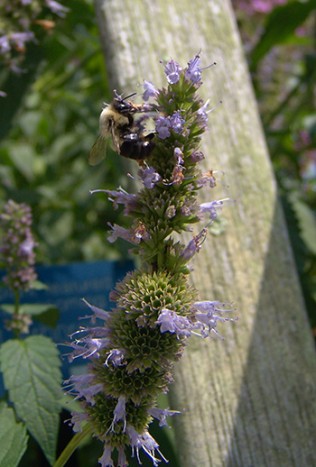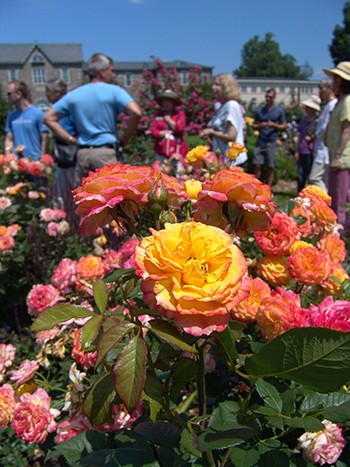 Have you visited the modern rose garden? The one interplanted with all types of flowering perennials, trees, and shurbs, alive with buzzing insects, chirping birds and awash in lovely scents. No longer will you find a garden of strictly roses with one month of wow and minimal interaction with birds, bugs, and bees. The renovated Dean Bond Rose Garden has been redesigned with sustainability in mind. The added benefit of considering sustainability in plant selection produces multi-seasonal interest in the rose garden as never before.
Have you visited the modern rose garden? The one interplanted with all types of flowering perennials, trees, and shurbs, alive with buzzing insects, chirping birds and awash in lovely scents. No longer will you find a garden of strictly roses with one month of wow and minimal interaction with birds, bugs, and bees. The renovated Dean Bond Rose Garden has been redesigned with sustainability in mind. The added benefit of considering sustainability in plant selection produces multi-seasonal interest in the rose garden as never before.
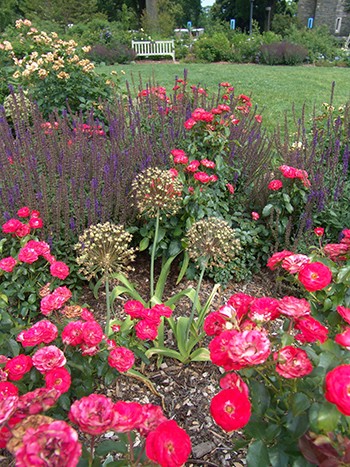
Today’s rose garden is interplanted with a variety of plants to encourage the growth of beneficial insect populations to help control unwanted pests. photo credit: R. Robert
Gone are the days of rose gardens with just roses, requiring the use of synthetic pesticides every two weeks, killing insects with no regard to beneficials, and creating harmful run-off into the environment. Today’s rose garden is interplanted with a variety of plants to encourage the growth of beneficial insect populations to help control unwanted pests.
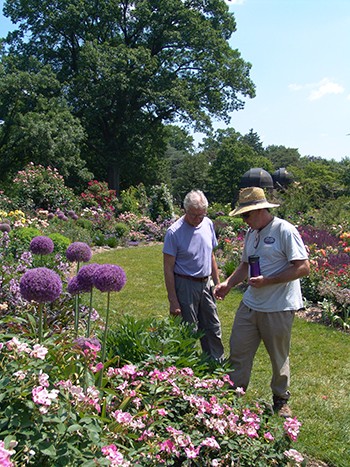
To attract pollinators and beneficial insects to the garden, our gardeners planted several flowering perennials to help sustain their life cycles. photo credit: R. Robert
To attract pollinators and beneficial insects to the garden, our gardeners planted several flowering perennials to help sustain their life cycles. Various types of plants need to flower before and after the roses bloom to provide a constant food source for beneficial insects in all their life cycles, not just during the month of June when roses bloom.
For example, the adult syrphid flies feed on pollen and nectar, while during the larval stage they feed on aphids and other soft-bodied insects. Controlling the aphid population prevents them from sucking plant sap which creates a sticky substance called honeydew. Aphids extrude this honeydew onto leaf surfaces creating an ideal growing medium for black, sooty mold. Providing nectar sources for adult syrphid flies results in syrphid fly larvae eating aphids, preventing honeydew on leaves, therefore controlling black, sooty mold.
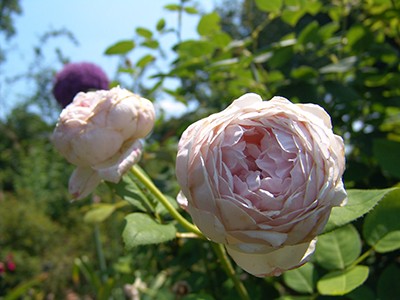
Saint Cecilla(R) Rose has been bred with so many petals that it is hard for pollinators to reach the pollen. photo credit: R. Robert
Most selections roses have been bred with so many petals that pollinators could not reach the pollen. Plants with open flowers have been chosen to encourage pollen collecting. The added benefit is that they look great in the garden.
Check some of our favorite garden plants for pollinators found the Dean Bond Rose Garden:
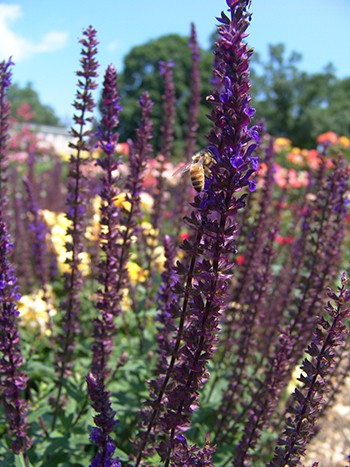
Saliva nemorasa ‘Caradonna’, an old world sage, blooms in April, May, and June and is a great source of nectar for honeybees, butterflies, and hummingbirds.photo credit: R. Robert
Salvia nemorosa ‘Caradonna’, an old world sage, blooms in April, May, and June and is a great source of nectar for honeybees, butterflies, and hummingbirds. It attracts orange-barred sulphur, monarch, cloudless sulphur, giant swallowfly, zebra longwing, gulf fritillary, and spicebush swallowtail butterflies to name a few. As a garden plant, S. ‘Caradonna’ has dark purple flower stems with blue-violet flowers. It is also a drought tolerant plant.
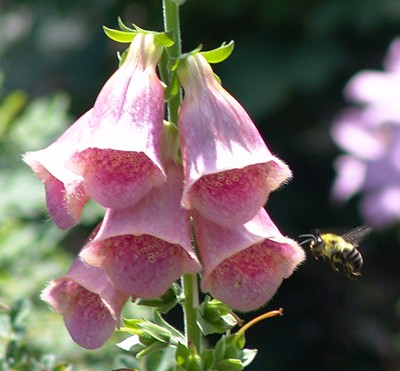
Digitalis x mertonensis, strawberry foxglove, has stunning deep rose-pink flowers grown on pendulous clusters on one-sided racemes. photo credit: R. Robert
Digitalis x mertonensis, strawberry foxglove, has stunning deep rose-pink flowers grown on pendulous clusters on one-sided racemes. This early summer bloomer attracts pollinators like hummingbirds and honey bees with its sweet nectar. Typically living 2 to 3 years, rosettes of leaves can be divided every two years to maintain vigor.
Agastache ‘Blackadder’, giant hyssop, has extended bloom from June to September. This upright clump-forming cultivar has smoky red-violet flowers blooming on bottle-brush terminal spikes with fragrant foliage. This deer-resistant plant serves as a nectar source for hummingbirds, bees, and butterflies. The flowers are cross-pollinated primarily by honeybees, bumblebees, digger bees (Melissodes spp.), leaf-cutting bees (Megachile spp.), Halictid bees (Lasioglossum spp., etc.), and Masked bees (Hylaeus spp.), which seek nectar or pollen. Other occasional visitors are Syrphid flies, bee flies, and various butterflies, skippers, oligolectic bees, and moths.
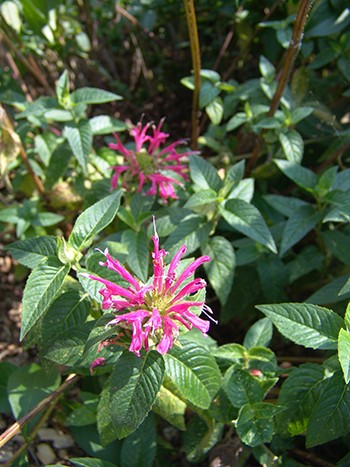
Monarda didyma ‘Coral Reef’ has coral blooms that extend the rose garden flower season into July. photo credit: R. Robert
Monarda didyma ‘Coral Reef’ has coral blooms that extend the rose garden flower season into July. This mildew resistant cultivar has large, shaggy flowers and fragrant foliage. The sweet nectar attracts long-tongued bees, bee flies, butterflies, skippers, hummingbird moths, Miner bees, Epeoline Cuckoo bees, and large leaf-cutting bees, to name a few. Caterpillars of the Sphinx eremitus (Hermit Sphinx) and Argiopodes teratophora (Gray Marvel) feed on the foliage. Seedbugs (Ortholomus scolopax) can be found feeding on the seedheads.
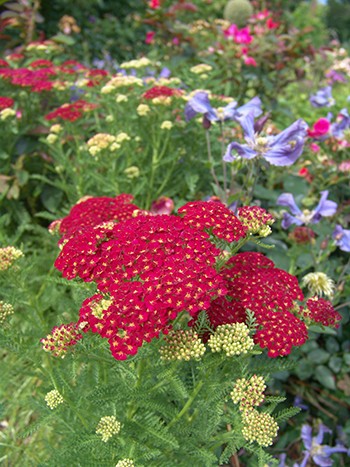
Achillea millefolium ‘Pomegranate’ has striking pomegranate colored flowers that bloom in dense, flattened clusters from June to September. photo credit: R. Robert
Achillea millefolium ‘Pomegranate’ has striking pomegranate colored flowers that bloom in dense, flattened clusters from June to September. This rhizomatous, spreading, upright perennial does well in full sun. Achillea attracts bee flies, Syrphid flies (including drone flies), thick-headed flies, Tachinid flies, flesh flies, Anthomyiid flies, and others. Additionally many species of grasshoppers, aphids, seed bug, flower thrips, leaf beetles, and caterpillars of some moths feed on yarrow.
Experiment with interplanting roses with perennials and discover what pollinators one attracted to the garden as well as what pests are controlled. Many of these great plants are available at the Scott Arboretum Plant Sale on September 12 through 13, 2015.

